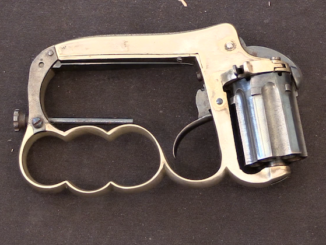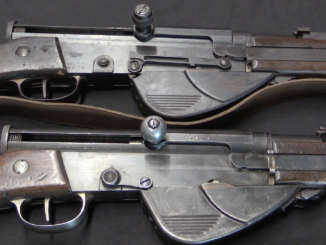Get your “Only Dropped Once” shirt here, and do your part to push back against the stereotype of the French soldier!
In the aftermath of World War One, the French military instituted a plan to introduce a completely new roster of small arms. This would begin with the development of a modern rimless rifle cartridge, which was adopted in 1924. With the new cartridge in hand, programs were begun to develop a light machine gun, bolt action rifle, and semiautomatic rifle using it. To supplement these new arms – especially during their development and production – plans were also made to convert existing 8mm rifles to the new cartridge.
The two rifles in large supply, of course, were the Lebel and the Berthier. The St Etienne arsenal was tasked with developing a Berthier conversion (this would become the M34 Berthier), and the Tulle arsenal was assigned to do the same with the Lebel. The first prototype was ready for testing in 1927. That first example was not satisfactory, and iterative development would continue into the early 1930s. Ultimately, the Lebel conversion was simply not as well liked by troops or as effective as the M34 Berthier, and so the Berthier was chosen for mass production. A total of about 1500 Lebel M27 conversions would be made by 1940, in a wide variety of configurations including different barrel lengths, rifling patterns, and optics mounting setups. While this did not result in a successful production rifle, it would inform the development of the MAS-36, and not go to waste. In addition, a number of M27 rifles would be converted into pressure testing guns to assist in ammunition development.




I feel rather sorry for the M27. Apart from the usual French disdain for a safety catch, it seems like a perfectly good bolt action rifle.
The sad thing is that if the French had not been so eager to adopt a new rifle in 1886, then this could easily have been the rifle they used in the First World War, as there is nothing in it which could not have been developed before 1914.
I think the French soldier would have much preferred one of these M27s over a standard 1886 Lebel if that had been possible.
“if the French had not been so eager to adopt a new rifle in 1886, then this could easily have been the rifle they used in the First World War, as there is nothing in it which could not have been developed before 1914.”
I don’t agree, someone must adopted new-fangled smoke-less powder to spark development.
In fact ye before 1914 French were on way to self-loading rifle “for everyone”, that they don’t manage to make it reality is another matter
http://modernfirearms.net/en/military-rifles/self-loading-rifles/france-self-loading-rifles/meunier-m1916-eng/
Well, the French had a rifle in 1886 which was obsolete within a decade, but which they were still using in 1939. I think it would have made sense not to rush the development of the 8mm Lebel. By the mid 1890s they could have come up with a rifle like the M27, and it would have served them well. They might even have thought about a safety catch, just like every other modern rifle!
With a bolt-action, you really don’t need a safety. You *really* don’t. The most reliable safety in existence is an empty chamber, and doctrinally, that’s how these kinds of guns were stored and carried.
Steven:
Might there be a reason why every bolt action I can think of apart from the French comes with a safety catch?
Lots of failures made before a successful product demonstrate that nothing is actually perfect on the first try. Let’s be grateful that nobody assumes a picture perfect environment today during the design phase…
“Lots of failures made before a successful product demonstrate that nothing is actually perfect on the first try”
C&R Arsenal has article: http://candrsenal.com/rifle-french-lebel-mle-1886-m93-m27/
Notice length difference between Mle. 1886 M93, Mle. 1886 M93 M27 and Mle. 1886 M93 R35, so there did not exist one-fit-all approach, but rather weapon of suitable length for usage.
Waiting for R35 ( as I own one) of course there just is not all that much to it compared to the R27
Other conversion that would be a nice bit for Forgotten (or at least misunderstood ones) Weapons might be the 8×57 Carcano conversions. (again I own one.)
Looking at design features and workmanship on Lebel rifles – they look pretty good to me. If Berthier was able to carry more rounds in its abbreviate magazine it would be even more attractive (I have to admit, I like it). In reality however, they came soon with brand new rifle and they did right decision.
Recalling some testimonies by volunteers who came to France just before outbreak of war, they spoke about large number of “outdated rifles”. I suppose it was Lebel they talked about.
At least they had functional weapons. Compare France to Germany in terms of machine guns and tanks produced by domestic facilities (not weapons taken from other places like Czech tanks and machine guns), and the former had the advantage. And remember, had politics and stupidity not been in place (along with overblown moral obligations misplaced by a decade), the French heavy bombers could have indiscriminately reduced the Rhineland to smoldering wasteland within a week while the hitherto undersized Luftwaffe was over Poland! Did I mess up?
This point had been discussed here couple of times before; put is simply French general staff did not shine with operational flexibility, to put it mildly. Talking something like ‘common sense’ is completely out of place.
Weapons and determination of people might have been in place, but command was not. For one thing I recall from mentioned testimonies (and those people who came to assistance of France as beacon of freedom did so with pure intention in heart); they were not people from colonies who would be procured as vassals).
Imagine: they (volunteers) were relegated to serve as foreign mercenaries – in Foreign Legion. To me, this would be an insult.
Ok Ian. It’s not pronounced “Tula”. It’s closer to to “Tool”.
You sort of swallow the E at the end. If it was Russian it would be Tula. But it’s not.
Wouldn’t the barrel’s twist be to the left? Seems to me the G would stand for Gauche or Left.
BTW that word PAS is also used for screws.
You are probably correct. This information on original Lebel 86/93 rifle says: “four grooves, right to left twist” (not exactly logical, but anyway…)
https://wikivisually.com/wiki/Lebel_Model_1886_rifle
British were proponents of LH rifling twist because they believed it mitigates Earth rotation (at Northern hemisphere). In practical sense however most armies carried on with RH twist which addressed natural twist reaction by right-handed shooter.
The info on this website: http://armesfrancaises.free.fr/FR%20Mle%201886%20M93%20M27.html
does state that the twist is left-hand with a pas of 235mm, which if my math is right would come out to 1:9.25 inches.
Correct. For energy they have 335kg/m… it should be kg.m (mass times velocity square).
Sir, thanks so much for your video on the m27. Can you please tell me if the disassembly of the bolt on the m27 the same as the m1886. Thanks again.
I have an M27, serial# 1223 (except bolt is serial# 403). Barrel is marked MAT 1935 and Pas 270G. The rifle was found in a small weapons cache that my dad’s unit found. He picked out a German Mauser 9mm semi-auto pistol, a Beretta Gardone 6.5mm, and this Lebel M27. A cousin was able to find ammunition and they have fired the gun. It seems to be in working order.
You say that this weapon is very rare in the US. Just how rare, and do you have any idea of its value?
Thanks
i also have a lebel m27 was wondering if you ever found out its worth. thank you